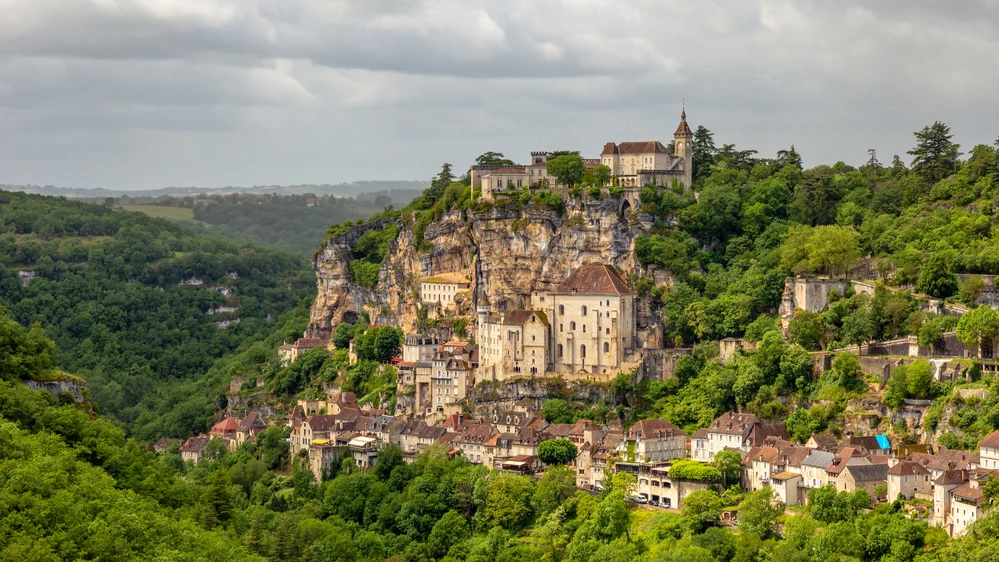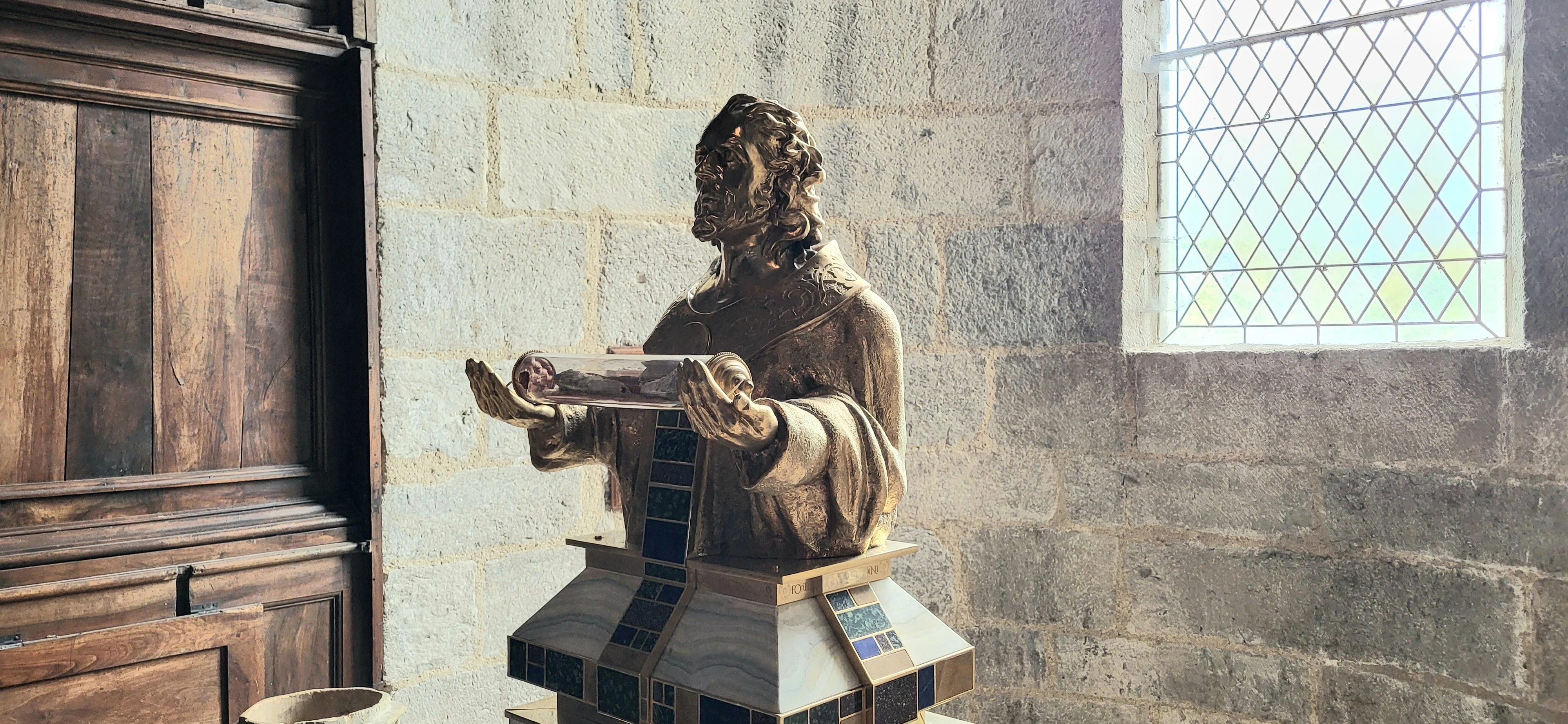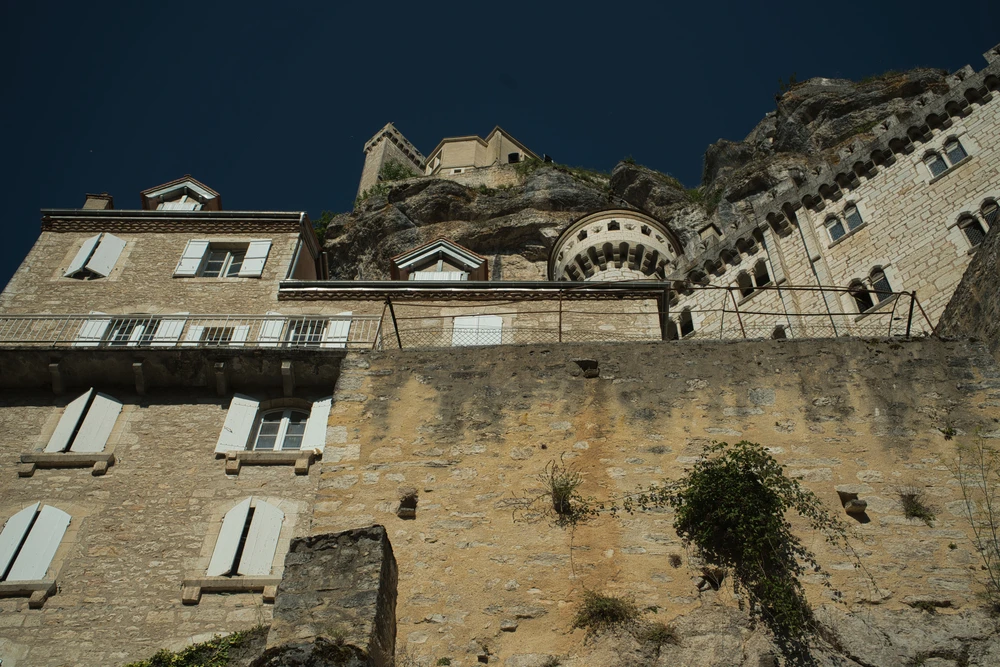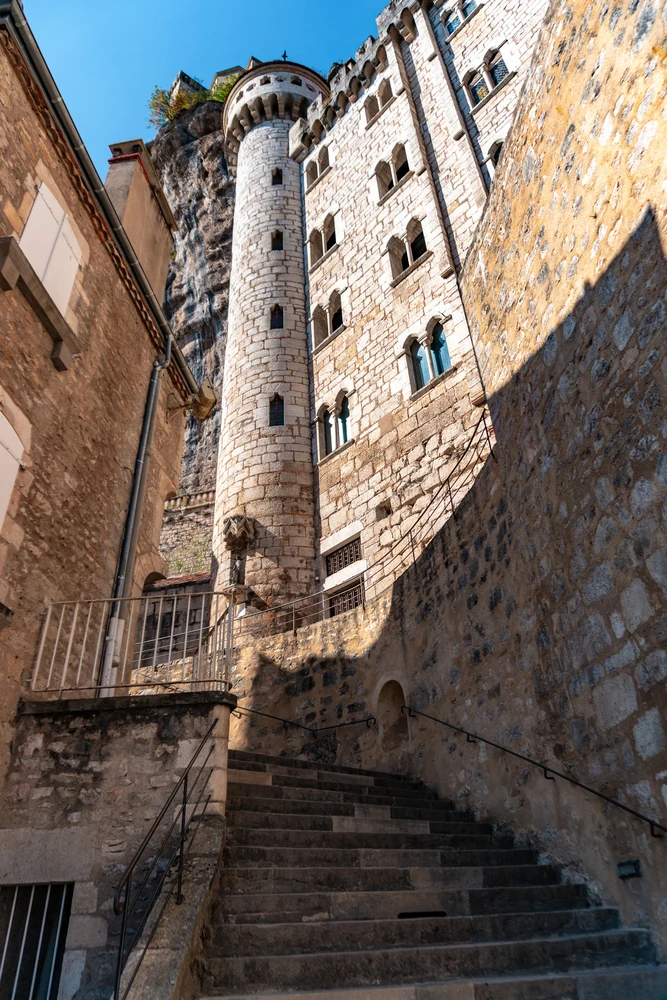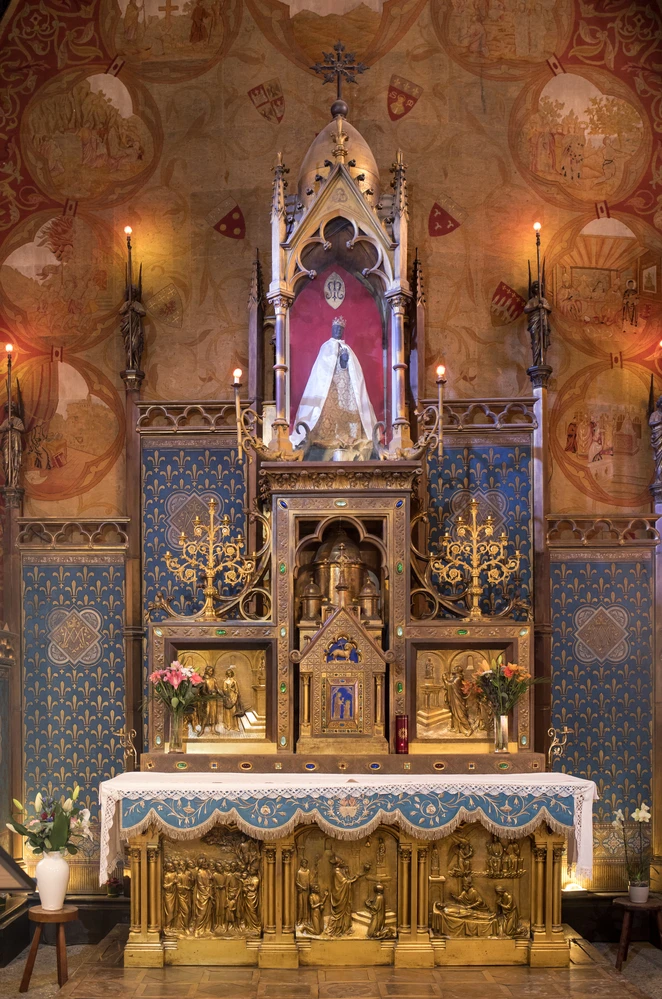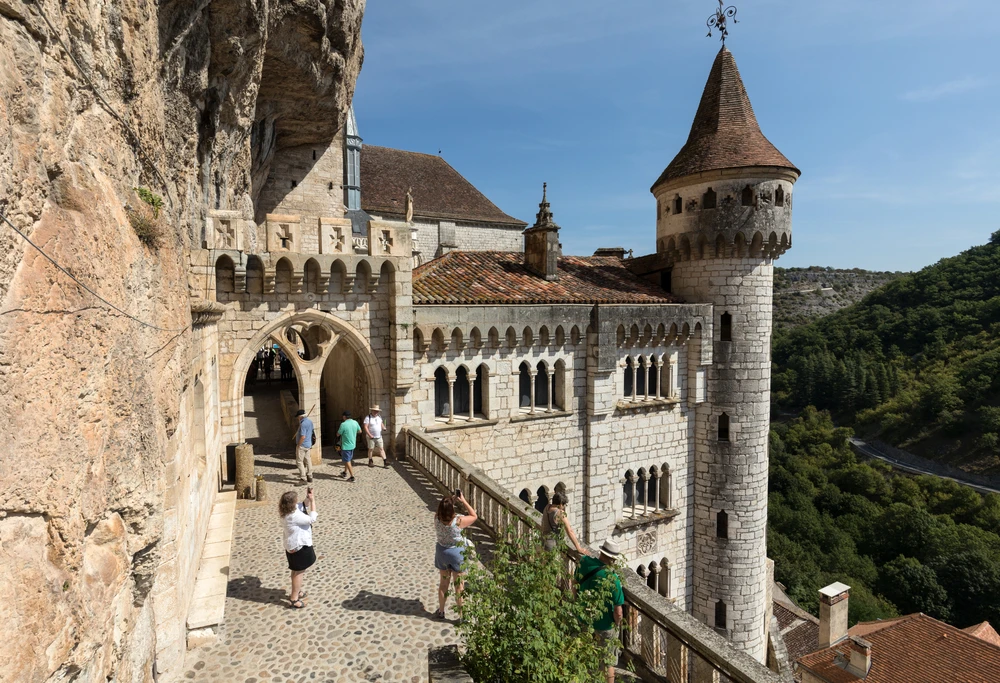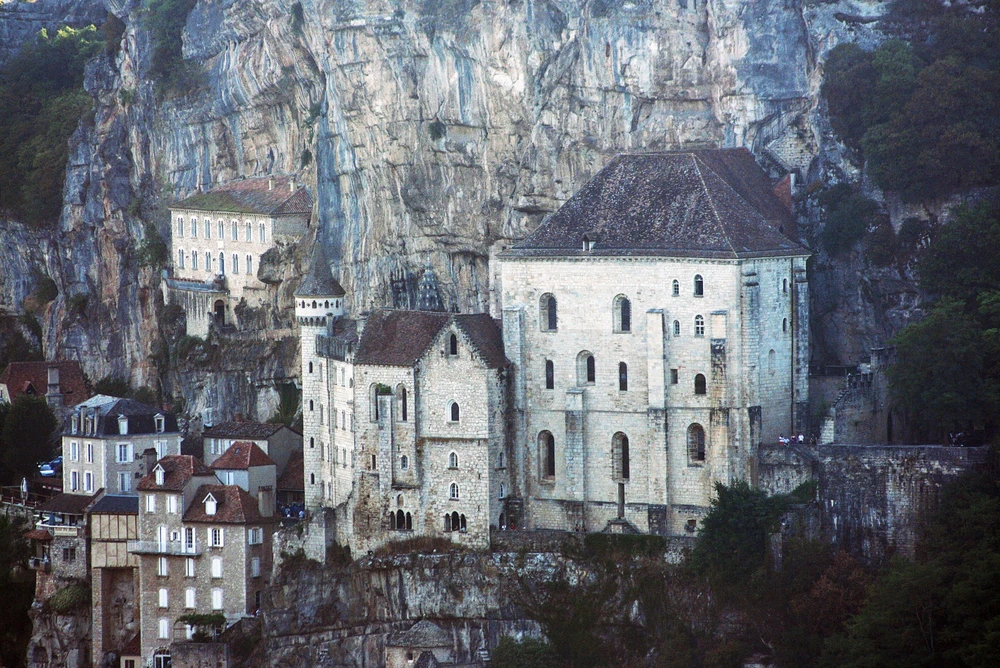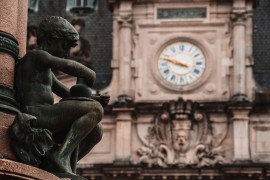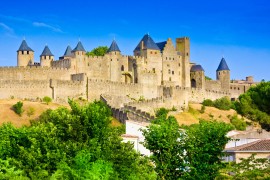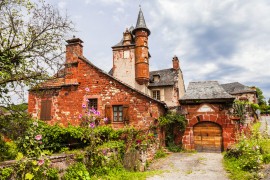I might as well be honest: there can be a few translation errors. Our translator tends to overdo the good stuff... And with so much good stuff around, we fear the worst. So bear with us!
Rocamadour: what you need to know
It's a cliff overlooking the bed of a small river (the Alzou), with a village of just over 600 inhabitants perched 150 metres above it. At the bottom is the medieval town (where the craftsmen and shopkeepers lived), in the middle the Marian shrine, and at the very top the castle. You can explore the site on foot and walk up or down it (depending on where you arrive, but most people walk down the cliff as the car parks are at the top). There are 216 steps, which some pilgrims climb on their knees, but there are also lifts which are very useful for the elderly and disabled. The village is somewhat isolated, surrounded by unspoilt nature, with a Natura 2000 site, a protected site and protected areas. Enough to delight lovers of history and nature, and to help the faith of those who believe and want to meditate.
Rocamadour clinging to its cliff. Photo chosen by monsieurdefrance.com:RFoto-VDW via depositphotos.
Le Roc d'Amadour
Legend has it that Rocamadour means "the Rock of Amadour", in other words the place of Saint Amadour, a saint from Quercy, the historic province where Rocamadour is located. Legend has it that he was a Christian hermit who settled there at the very beginnings of Christianity. According to some, he was the husband of Saint Veronica, the woman who sponged Christ's face as he climbed the Way of the Cross. He was therefore a contemporary of Jesus Christ. His body, intact, was found in the 12th century when a tomb was being dug. Exposed to the veneration of the faithful for several centuries, it is said to have been the source of 126 miracles . Miracles that attracted ever-growing numbers of pilgrims. The holy remains were vandalised in 1562 by a Huguenot captain, as the Huguenots considered the veneration of the saints to be superstition contrary to the Christian faith. The story goes that this captain, named Jean Boissonas, extracted the body from its hunt in order to burn it but, unable to do so, he cried out "since I can't burn you, I'll break you" before destroying it with a hammer. The few bones left from the ransacking were recovered by local residents, hidden away and later brought to light. They can be seen in one of the sanctuary chapels. It was this Saint Amadour who is said to have decided to dedicate the site to the Virgin Mary (whom he is said to have represented in the form of a sculpture).
The reliquary containing the remains of Saint Amadour / Photo chosen by monsieurdefrance.com: Jérôme Prod'homme (c)
A major Marian site
Since the early Middle Ages, Rocamadour has been a pilgrimage site for Notre Dame de Rocamadour, celebrated on 8 September and venerated, among other things, for her ability to perform miracles (there are many ex-votos in the sanctuary) and for being the patron saint of sailors. It was mentioned by a pope in the 12th century, and has been visited by many famous figures over the centuries, including Saint Anthony of Padua, Saint Louis and his mother Blanche of Castile (1244), Louis XI (twice), Louis XIII... More recently, Sister Emmanuelle. Tradition has it that pilgrims arrive at the place known as "l'hospitalet", at the bottom of the village, and climb the steps to go and pray at the sanctuary (216 steps). The Notre Dame chapel is surrounded by other chapels, mainly dedicated to members of Christ's family.
Seen from below, it's easy to see the height you have to reach when walking to the shrine. Photo chosen by monsieurdefrance.com: alfidefrutos@gmail.com via depositphotos
A major city
Pilgrimage means the needs of pilgrims, which means trade, and little by little an opulent trading city grew up around the sanctuary, mainly below. The city was enclosed by gates and partly by walls, since the cliffs on the other side formed a natural wall. This didn't stop the town from being taken, pillaged and burnt down by the Huguenots in 1562. It eventually fell into decline as the sanctuary began to lose importance, particularly following its partial destruction during the Wars of Religion. It was in the 19th century that Rocamadour came back strongly in the memory of people and in the faith of Christians when the shrine was restored and partially rebuilt by a bishop who wanted to revive the Marian cult. A successful gamble, since the site is still a major Christian site in France today.
Rocamadour what to see?
The staircase leading up to the sanctuary from the medieval town.Some pilgrims climb it on their knees. Photo chosen by monsieurdefrance.com: TRSTOK via depositphotos
The medieval city
The town lies on the side of a cliff. It's a small village, one of the most beautiful in France, starting at the bottom with the hospital and the church of Saint Jean Baptiste de l'Hospitalet (a listed monument), continuing with the sanctuary and ending with the castle. In the "medieval town" , you'll find plenty of shops and restaurants. You'll pass a number of beautiful old houses , such as the Maison Mazot (the town hall) and the Maison de la Paumotte (Renaissance). This is also where you'll find the fortified gates and, above all, the start of the ascent to the sanctuary. There is a lift that takes you up to the sanctuary and even, ultimately, to the top of the cliff. Very practical for old-timers and R.M.P.s.
The Sanctuary
Notre Dame de Rocamadour in the Notre Dame chapel / Photo chosen by monsieurdefrance.com: wjarek via depositphotos
As you leave the medieval town, you will see the grand staircase leading up to the sanctuary. Don't be surprised to see people climbing it slowly and with difficulty on their knees out of piety. The Rocamadour sanctuary is made up of no fewer than 7 churches. At the top of the staircase is a courtyard that could very well be the setting for a TV series like Games of Thrones. The Basilica of Saint Sauveur is the oldest church, dating back to the 11th century, but largely rebuilt in the 19th century due to its ruins. It contains the relics of Saint Amadour (in a superb reliquary in the shape of a man's bust). There is also the Notre Dame chapel, which houses the black Virgin: Notre Dame de Rocamadour. Many candles burn here all year round. There isalso the chapel of Saint Blaise, the chapel of Saint Michel (you can clearly see the archangel thrusting his sword into the dragon) and the chapel of Saint Louis. There are also chapels dedicated to Christ's family: the chapel of Saint John the Baptist, his cousin, whose stained glass windows tell the story of his life and torture (his head cut off and placed on a tray at the request of King Herod's daughter),the chapel of Saint Anne, mother of Mary, grandmother of Jesus and Patron Saint of grandmothers. We can also see Saint Zacharie, her husband, Patron Saint of grandfathers. The Palace of the Bishops of Tulle is located a little further up. Once you have explored the sanctuary, you can exit by passing under the basilica through a porch that leads to the Way of the Cross. This is a sort of park, with a winding path running through it, punctuated by 12 chapels containing statues at each of the 12 stations of Christ, in other words his last moments.
The Episcopal Palace, just above the Rocamadour sanctuary. Photo chosen by monsieurdefrance.com: wjarek via depositphoto
The top of the cliff.
Once you've climbed everything, including the cliff, you'll reach the top of the cliff. You'll have an absolutely magnificent view of the valley and the surrounding area. It's beautiful, it's green. It's worth a look. You can gain a few more metres and another great view by visiting the little castle.
Rocamadour is a village in the middle of a magnificent natural area. Photo chosen by monsieurdefrance.com: Depositphotos.
Animal parks and protected natural areas
Rocamadour is also well worth a visit for nature lovers. Firstly, a large part of the commune is classified Natura 2000. There are also several protected areas. Finally, the monkey forest is home to 150 'magot' monkeys in a 20-hectare park, and 'le rocher des aigles' is a magnificent ornithological park.
The monkey forest is a must-see. Photo chosen by monsieurdefrance.com: photo chosen by monsieurdefrance.com: AWP via depositphotos
What's more
Rocamadour has its own café théâtre, the "café théâtre côté rocher" , to keep you entertained with its comedy creations and one-man shows, and "le rocamadour" is a delicious goat's cheese (A.O.P and A.OC).
Where is Rocamadour? Geo / web info
Magnificent and astonishing cliffside buildings in Rocamadour. Photo chosen by monsieurdefrance.com: uldiszile via depositphotos
Rocamadour has a population of just over 600: the amadouriennes and amadouriens. The commune is located in the Lot department, the former province of Quercy in the Occitanie region.
By road
Rocamadour is 1 hour from Brive la Gaillard, 1 hour 15 minutes from Sarlat and close to Périgord, 2 hours from Toulouse, 3 hours from Bordeaux, 3 hours 45 minutes from Montpellier and 5 hours 30 minutes from Paris.
By train
Rocamadour is accessible by train via Rocamadour Padirac station.
By plane
Brive la Gaillarde Vallée de Dordogne airport is the nearest, with 4 flights a day to Paris Orly in fine weather (1H10).
Website

